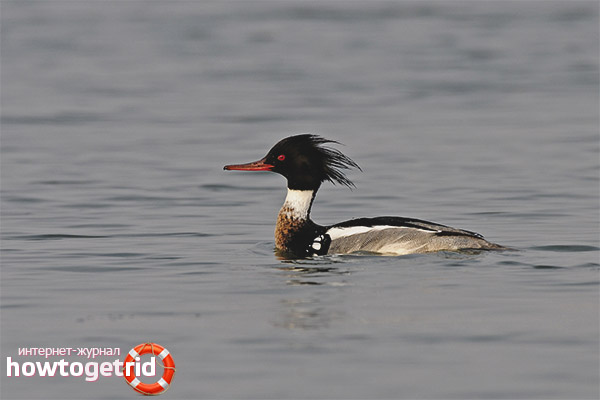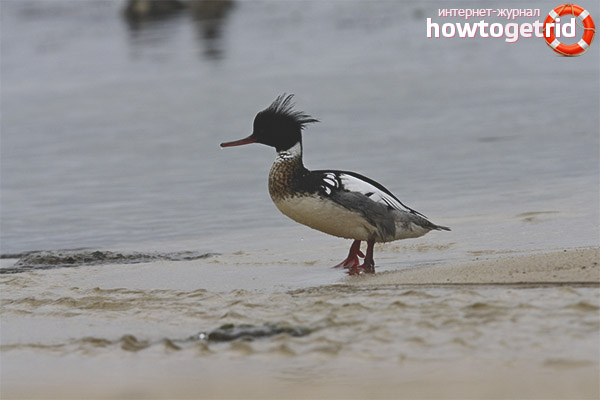The content of the article
There are only 4 species of merganser, but today our focus is on the long-nosed duck. It is common in various parts of the world, therefore, deserves a separate description. Individuals are famous for interesting behavior, as well as overall features and external data. Today, most of the population is dispersed throughout Europe, more precisely, its western part, as well as in the Himalayas, Japan and on the shores of the Atlantic Ocean.
Description
- From the individuals of the presented breed group, excellent dives were obtained. A distinctive feature is the elongated beak, as well as the color of the feathers. According to the overall characteristics of the bird, sometimes it reaches 60 cm. It is also important to take into account the wingspan, which is 70–90 cm. As for the weight, it cannot be said that the birds are huge. Their mass varies between 1-1.2 kg.
- The nose is reddish, the head is black with a greenish sheen. The duck has white feathers in the neck and chest, reminiscent of a certain collar in its pattern. The males have a double tuft, as well as a band near the goiter.
- The chest is spotted, red and black in hue. The side parts are gray, the pattern is flowing. In the upper region of the wings there are spots and a patterned contour. The back and cervical region include a strip of dark tone (usually black).
- Females are almost identical. Their plumage is grayish, patterned, slightly striped. On the head there is a cup of reddish tint with a gray sheen. The abdominal section is whitish, the neck is gray with red, there are no clear boundaries in the transition of tone.
- The upper part of the body is light with a shade of brown. There is a dark line in the mirror area, followed by a white stripe. Females and males practically do not differ in tone, except that in males, the back area is black and brown.
- In the duck, the line between the eyes and the nose is noticed, but the representative of the male side does not have this feature. Males are famous for their reddish iris, and in females it is brown.
- Young growth has not yet formed in terms of its coloring. Its plumage tone is dark, the forelock is not elongated. When an individual reaches puberty, it will acquire all the features characteristic of this species. Young animals have grayish paws with a slight redhead. In males up to 12 months of age, the color is constantly changing, it either looks like a female, then a male.
Habitat
- Mergansers of this category prefer to settle where there are thickets and some course. That is, they are attracted by weakly flowing rivers, lakes with sufficient depth (do not forget that the birds are excellent dives). They also love all kinds of streams passing through a wooded area.
- You can meet representatives of the breed group in the tundra, as well as water sources with brackish water. They coexist perfectly in bays, in shallow water, in straits and bays, in estuaries with sand at the bottom. They do not like silt, so they refuse such water sources.
- Birds will always choose narrower channels instead of open water for human eyes. They try to dwell near the rocky terrain, trees, shrubs near the water, grassy plants. Prefer islets and braids.
- When the nesting period comes to an end, the birds go for wintering in the open sea. They feed in brackish lagoons or bays. Individuals do not like waves, swim only in clean water. During the flight to the place of wintering, they stop for a snack in small freshwater sources.
Breeding
- The presented mergansers give preference during nesting to the banks of mountain rivers. They can also build nests on various islets.Often, such manipulations occur in the spring. Birds nest in colonies or in pairs. Individuals begin to build a nest at a distance of about 20 m from the water.
- Often birds arrange their homes to reproduce offspring in natural depressions that are located in the ground. Nests can be under large stones, in cracked rocks, in the roots and crowns of thick trees. They can also be found in hollows and reeds.
- The considered individuals always choose secluded and quiet places for nesting. This is done so that the female that hatches eggs is not visible to the outside world and predators. At the bottom of the nest of the birds are lined with dried grass and their own fluff.
- Females can nest in one place for many years. In clutch there are often no more than 12 eggs. They can be painted in a creamy or creamy shade. The duration of hatching offspring can last up to 35 days. Already at the age of two months, young mergansers learn to fly.
- In mid-summer, males hatch in flocks and move to tundra rivers and shallow bays. At this time, molting occurs in birds. Also, such a process often occurs in nesting places, in the area of forests. I reach sexual maturity at the age of 3 years.
Nutrition
- Often, these individuals feed on small fish, invertebrates, plants, larvae, insects and worms.
- The feeding process in birds takes place in schools on shallow shores. Overwinter individuals fly away to the mouths of shallow bays.
Interesting Facts
- The bird population is declining significantly every year. The problem is that such a game is popular among hunters. In addition, individuals often die in fishing nets.
- The bird population is rapidly declining due to habitat disturbance. People cut down forests, build dams and pollute water bodies. In addition, individuals are susceptible to bird flu.
- Ducks have long been placed under protection in European countries. Due to this, the population of the species began to increase on the islands. To preserve the appearance of birds, people build artificial nests on their own.
Long-nosed mergansers belong to a rather interesting species of birds. In addition, such birds also have subspecies. Unfortunately, the population of individuals is declining mainly due to human activities.











Submit